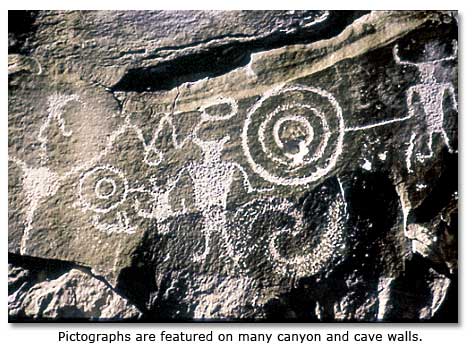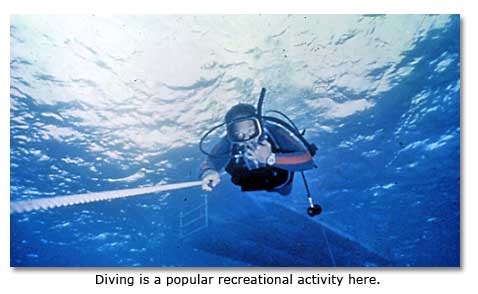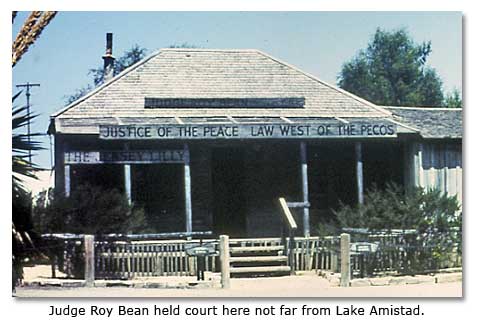Lake Amistad - Texas
Recreation Area - Houseboats - Fishing
Scenic Lake Amistad, with 800 miles of shoreline, began filling with water on May 31, 1968, following completion of a dam across the Río Grande. Built as a joint project between the United States and Mexico under an international agreement, the dam for Amistad – the Spanish word for “friendship” – was dedicated by Presidents Richard Nixon and Díaz Ordaz on September 8, 1969. Today, the National Park Service manages Lake Amistad, which is located 12 miles northwest of Del Rio, Texas.

Under the bright sun, the sparkling blue water in Lake Amistad and its four main “arms” and numerous coves is pleasantly warm nine months of the year. December, January and February temperatures will occasionally fall into the low 30’s Fahrenheit, bring a chill to the water. The lake provides outstanding opportunities for water sports, fishing, limited hunting and general outdoor enjoyment. Ironically, the area now receives about three inches less rain a year than in the past, the result of a microclimate created by the full lake.
The First Texans
The Lake Amistad area has some of the oldest and best-preserved archaeological sites in North America. Radiocarbon dating has shown that humans first inhabited the area near the end of the last Ice Age, about 11,000 years ago. Archaeologists have uncovered more recent bone and wooden implements, textiles, food remains and human burials from various sites. The evidence indicates that the area was occupied by small nomadic bands of game hunters and wild plant gatherers. The most conspicuous thing left behind by the first Texans is their pictographs, or rock paintings, in stone alcoves. These remarkable pictures, of human and animal-like figures, geometric designs, and difficult-to-identify objects, are found in over 150 sites in the area. Some pictographs are over 15 feet in height and contain as many as five distinct colors.

The National Park Service has developed two archaeological sites, Parida Cave and Panther Cave, for visitors. Accessible only by boat, the sites can be reached easily from Park Service boat docks. Tours operated by concessionaires are available for visitors without their own boats.
Major Activities
Major activities include wilderness experiences, boating, water skiing, swimming, fishing, camping, picnicking and hiking.
If you enjoy wildlife, you may find, for example, mammals such as deer, collared peccary, raccoons, jackrabbits and rock squirrels and reptiles such as kingsnakes, rattlesnakes, turtles, tortoises and many lizard species. Waterfowl also find refuge on the lake’s expanse.

Amistad has three major boat ramps: Pecos, Diablo East and Rough Canyon. The Pecos ramp, near the mouth of the Pecos River, is located 44 miles from Del Rio. The gasoline and store facilities nearest the Pecos ramp are at Comstock, 12 miles to the east. Diablo East is 10 miles from Del Rio along a road off of U.S. Highway 90; a concessionaire provides boat rentals, rental slips, fuel, bait, ice, snacks and beverages. Rough Canyon, 23 miles from Del Rio on Recreation Road No. 2 off U. S. Highway 277, has similar facilities.
You can drive to the water’s edge only at designated sites, and launching a boat from a trailer can only be done at such sites. Boat registration at launch ramps is required. Your boat must have a fire extinguisher, and it must have a Personal Flotation Device for every person aboard.
 Principal sport fish include largemouth bass, striped bass, white bass, catfish, crappie, trout, walleye and sunfish. If you fish only in U. S. waters, a Texas state fishing license is all that is required. Texas licenses are sold at hardware and bait shops in Del Rio. Should you cross from the U. S. portion of Lake Amistad to the Mexican portion to fish, you must have a Mexican fishing license that is good for 90 days. Everyone in the boat must have a Mexican fishing license, whether fishing or not. Mexican licenses may be obtained in Ciudad Acuña at a building just across the road from the Mexican Customs checkpoint at the end of the International Bridge. There is no closed season on fishing.
Principal sport fish include largemouth bass, striped bass, white bass, catfish, crappie, trout, walleye and sunfish. If you fish only in U. S. waters, a Texas state fishing license is all that is required. Texas licenses are sold at hardware and bait shops in Del Rio. Should you cross from the U. S. portion of Lake Amistad to the Mexican portion to fish, you must have a Mexican fishing license that is good for 90 days. Everyone in the boat must have a Mexican fishing license, whether fishing or not. Mexican licenses may be obtained in Ciudad Acuña at a building just across the road from the Mexican Customs checkpoint at the end of the International Bridge. There is no closed season on fishing.
In a lake as large as Amistad, it is wise to never swim alone; do so in the company of at least one buddy. It’s fun to swim from a boat, but anchor first and never start the engine while swimmers are overboard. Protected swim beaches are found at the dam, Governor’s Landing and Rough Canyon (lake levels permitting). Water skiing is permitted only during daylight hours. There must be both an operator and a competent observer in the towing vessel. Water skiers must wear an approved life-saving device. Skiing is not permitted in channels, within 500 feet of harbors, swimming beaches, mooring areas, or within 100 feet of any person in the water.
Scuba diving is allowed, but no diving is permitted in the harbors, protected swim areas, or anywhere near the dam. When diving, always use a dive flag. Register with a Park Ranger or at Park headquarters before you dive and get a copy of the booklet “Dive Amistad Safely.”
A canoeing/kayaking paradise
Amistad NRA has plenty of open space or steeply walled canyons, which makes it a great place for paddling your canoe or kayak. The park boundary extends 74 miles up the Rio Grande, 25 miles up the Devil's River and 14 miles up the Pecos River. Protected coves provide superb fishing and ideal camping spots. Amistad is an international reservoir -- the United States-Mexico border is marked by buoys that follow the historic channel of the Rio Grande. Amistad NRA does not require a lake use permit for non-motorized craft, but if you plan to paddle onto the Mexican side be sure to have a Mexican boating permit. Click here for maps.
Nearby
Del Rio, Texas, a pleasant border town with motels and restaurants, is an oasis in Val Verde County and a center for sheep and goat ranchers who produce wool and mohair.
Ciudad Acuña, Mexico, Del Rio’s Sister City, can be reached by following Garfield Avenue west to the toll bridge. You may leave your vehicle in the parking spaces available at the bridge. Board the international bus either at the bridge or in Del Rio. Take the green bus marked “Mexico.”
Ciudad Acuña’s quaint charms attract visitors, many of whom are drawn back again and again. One frequent visitor in the early 1920’s was the fabled Mexican revolutionary figure Francisco “Pancho” Villa. Acuña’s heartbeat, as in many Hispanic towns, is its traditional plaza or public square, known as Plaza Benjamín Canales, named after a hero of the Mexican Revolution. Acuña’s main street – Avenida Hidalgo – has shops well stocked with a variety of Mexican handicrafts, gifts and souvenirs.

IMPORTANT NOTE for U.S. citizens crossing into Ciudad Acuña: All Mexico visitors are NOW required to present a birth certificate or passport to U.S. Customs upon RETURN from Mexico. Persons going to Mexico without documents can be detained and issued a citation.
Lake Amistad is not merely a vast reservoir that stores water for flood control and water conservation. The dam is an engineering wonder, as audacious as the arid land itself. It is also a thing of beauty. The impression the dam makes is not unlike that made by a massive work of art—as if something that began with utility ended somewhere in the neighborhood of Beethoven’s Ninth Symphony. An international monument at the center of the dam – bronze eagles seven feet high – symbolizes the spirit of cooperation between the U. S. and Mexico.
If You Go
The National Recreation Area headquarters and visitor reception center are located in Del Rio on Route 90. Camping is permitted at designated campgrounds. Boat campers in undeveloped areas must carry receptacles suitable for trash. Campground sites are occupied on a first-come, first serve, non-reservation basis. Use fire grills provided in the campgrounds.
Each U. S. citizen 21 years of age or over can bring back one quart of liquor duty free from Mexico. Liquor brought into the U. S. is subject to state taxes. One hundred cigars (other than Cuban cigars) can be brought into the U. S. duty free. Undeclared liquor purchases violate Federal and Texas laws and incur heavy penalties for violators.
Del Rio’s restaurants offer what’s best along the border—barbecue, Tex-Mex and grilled steaks. Don Marcelino’s three locations serve delicious enchiladas suizas for $5, with complete dinners costing not much more. Betty’s Ranch House Café on Avenue F is local famous for its big breakfasts of grits and biscuits and for its lunch specials such as chicken fried steak with cream gravy. The Cedars, also on Avenue F, specializes in mesquite-broiled steaks and it serves Texas wines.
Caution
Winds on the lake can increase or change direction suddenly, causing dangerous wave conditions. Don’t try to cross the lake when winds and waves are high. Instead, seek shelter. It is not safe to stay on the lake or in any exposed place during electrical storms.
Lodging
Hotels/motels
There are hotels/motels in Del Rio, Texas with something for every taste and price range.
For map of the park Adobe Acrobat PDF screen-viewable file (1.1 MB)
For additional information on Amistad Recreation Area and the fees, contact:
National Park Service
HCR #3, Box 5J
Del Rio, Texas 78840
Telephone 1-830-775-7491l
Article by Joe Zentner
Share this page on Facebook:
The Desert Environment
The North American Deserts
Desert Geological Terms

Click here to see current desert temperatures!



